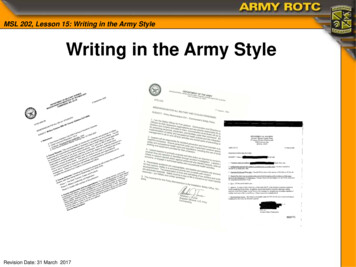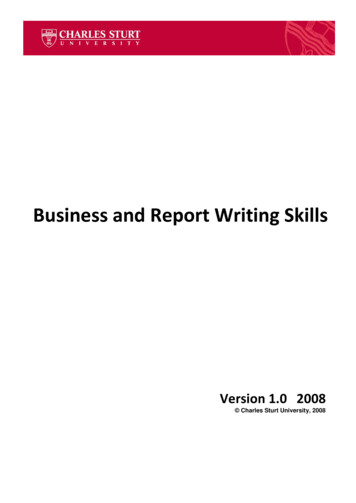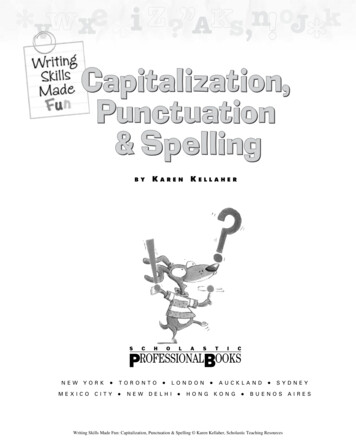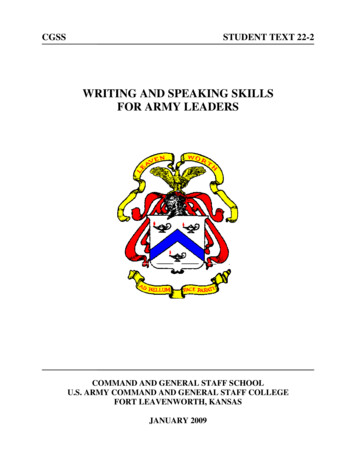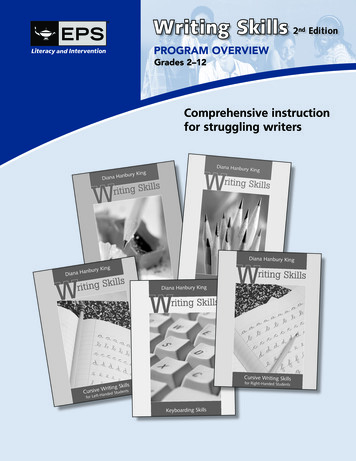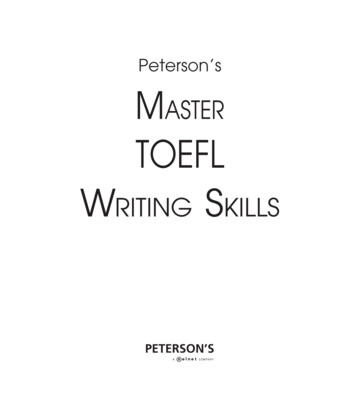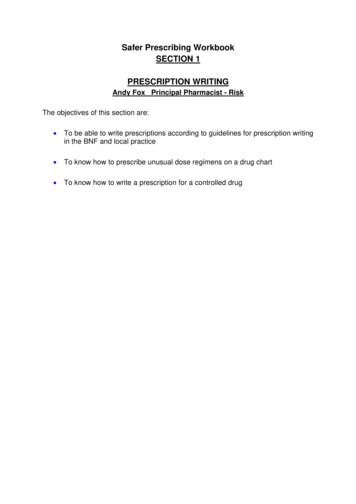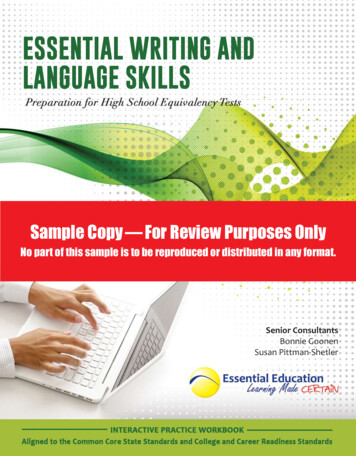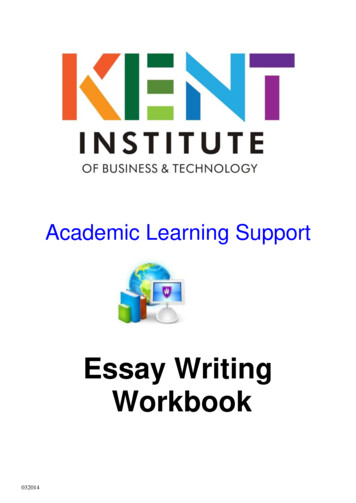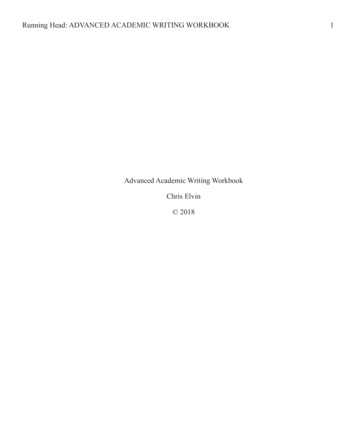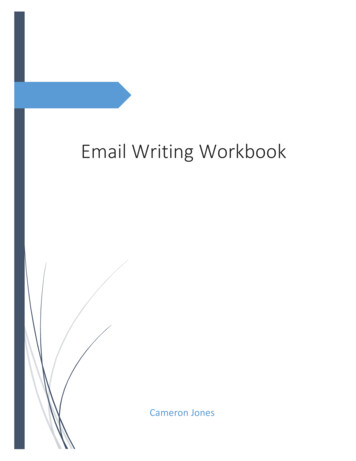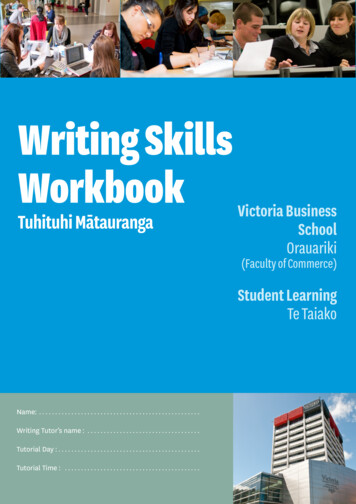
Transcription
Writing SkillsWorkbookTuhituhi MātaurangaVictoria BusinessSchoolOrauariki(Faculty of Commerce)Student LearningTe TaiakoName: . . . . . . . . . . . . . . . . . . . . . . . . . . . . . . . . . . . . . . . . . . . . . . . . . .Writing Tutor’s name : . . . . . . . . . . . . . . . . . . . . . . . . . . . . . . . . . . .Tutorial Day : . . . . . . . . . . . . . . . . . . . . . . . . . . . . . . . . . . . . . . . . . . . .Tutorial Time : . . . . . . . . . . . . . . . . . . . . . . . . . . . . . . . . . . . . . . . . . .
Introduction and WelcomeWriting is one of the principal ways in which we communicate. We do that ina variety of ways and in a variety of styles. Different styles often come withtheir own requirements. However, all writing is creative, and all writing canbe fun.University students are often assessed on the basis of their written work.Throughout any course of study, students at Victoria University will berequired to produce different types of assignments: essays, reports, casestudies, proposals, and literature reviews. In universities scholarly writingcomes with its own requirements – providing structure to an argument, usingevidence – and most importantly – acknowledging the sources that you use.Writing and research skills learnt at university are transferable to your laterworking life. Employers look for graduates who can communicate throughwriting and support their ideas with evidence. Employees agree that at least30% of their working time is spent writing.The Faculty of Commerce (also known as Victoria Business School) has clearaims to develop students’ writing over its many programmes.These written communication skills are outlined in the CommunicationsRubric (see p. ii). This writing handbook and the associated writing coursesupport these objectives by providing students with the basic skills needed towrite at the university level, regardless of the type of assignment. Writing is adevelopmental and a pivotal life skill and everyone can learn new ways toimprove their writing skills at different stages. This is an initial step in yourBCom and one which the Faculty hopes you will continue to build onthroughout your degree and beyond. Keep this book as a reference for yourwriting at Victoria and beyond, whether for academic or business audiences.Dr Chris EichbaumAssociate Dean (Learning and Teaching)Victoria Business School/Faculty of Commercei
VBS Rubric for Written Communication SkillsBCom Learning Goal 2Our graduates will be effective communicators.BCom Learning Objective 2aResearch, plan and produce written assignments meeting academic standards.SatisfactoryNot overly repetitive;some variety in sentenceconstruction; generallyflows well; someawareness of audienceand genre.UnsatisfactoryOverly repetitive orsimplistic sentencestructure; consistentlydisjointed, lack of flow;style/structureinappropriate foraudience.Clarity andconciseness:Answers the question,succinct, appropriatecomplexity.ExemplaryVariety of sentenceconstruction; logical flow;style and structureappropriate for task,audience and genre. Usesengaging delivery thatenhances understanding.Thoughtful presentation.Argument effectively andefficiently conveyed;highly focused on thequestion; easilyunderstood.Argument reasonablyclear; occasionally missesthe point but answers thequestion; not overelaborate or overcomplicated.Technical writing skills:Spelling, capitalisation,punctuation, grammar,general proofreading.Very few spelling errors,correct punctuation,grammatically correct,complete sentences.Occasional lapses inspelling, punctuation,grammar, but not enoughto seriously distract thereader.Vocabulary:Originality, breadth,appropriateness,variety.Highly appropriate, wellchosen, precise and variedvocabulary. Consistentlyuses correct word choiceand discipline-specificterminology.Uses APA (or acceptedalternative1) referencingsystem consistently andcorrectly.Appropriate use of others’work, acknowledged viain-text citations.Generally appropriatevocabulary; not overlyrepetitive. Generally usescorrect word choice anddiscipline-specificterminology.Generally uses APA (oraccepted alternative1)referencing system.Main point and/orargumentconfused/unclear.Irrelevant information,no transition betweenideas. Unclearconclusion.Numerous spellingerrors, non-existent orincorrect punctuation,and/or severe errors ingrammar that interferewith understanding.Excessively limited orinappropriate orrepetitive vocabulary.Misuses disciplinespecific terminology.Exemplary writtencommunication.Satisfactory writtencommunication.Structure and style:Document, paragraphand sentence structure,flow and layout,appropriate toaudience.Appropriate use ofreferencing system:Academic Integrity:Holistic judgement:1Other sources appear tobe acknowledged.Does not attempt to useAPA (or acceptedalternative1) referencingsystem.Work appears to be notadequately referenced orattributed.Unsatisfactory writtencommunication.APA is the VBS standard, but lecturers may either require an alternative when APA is not appropriate oraccept an alternative – in both cases guidance must be provided.ii
ContentsIntroduction and Welcome . iVBS Rubric for Written Communication Skills. iiCHAPTER ONE: STARTING TO WRITE . 1Essay Writing Process . 2Step one: Motivation. 3Step two: Analyse the question . 3Step three: Plan your approach . 4Step four: Research . 6Step five: Writing your first draft . 6Steps six & seven: Reworking your first draft & Checking your final draft . 6Sample essay. 7Structure: Paragraphs . 11Introductions and conclusions . 13CHAPTER TWO: RESEARCH, REFERENCING AND CITING SOURCES . 17The Library . 17Referencing . 21In-text referencing. 22Writing the reference list in APA format . 26Examples of APA formats . 27Sample reference list. 36CHAPTER THREE: POLISHING THE FINAL DRAFT. 38Editing. 38Steps to help you edit . 39Steps to help you proofread . 40Check your referencing . 41Presentation . 42Academic Writing Style . 43Grammar and spelling . 451. Incomplete sentences. 452. Run-on Sentences . 473. Subject-verb agreement . 484. Apostrophes . 485. Spelling . 506. Punctuation . 51REFERENCE LIST . 53APPENDIX 1: INSTRUCTIONAL WORDS . 54iii
APPENDIX 2: LINKING WORDS AND PHRASES . 56APPENDIX 3: PARAPHRASING . 58APPENDIX 4: ANSWERS TO SOME OF THE EXERCISES. 60iv
Chapter one: Starting to writeBeing able to express yourself clearly in written form is crucial for yoursuccess at university and in business. This book is designed to help youdevelop your skills in academic writing. It is a useful resource that will showyou how to structure your writing, do research, use APA referencingcorrectly and give you tips on grammar and spelling. Keep it as a referencefor the rest of your studies.While you are at university, you will be asked to complete a range of writingtasks including essays, reports, case studies and literature reviews. This bookwill focus on the essay as it forms the written assessment for FCOM 111;however, many of the skills it teaches will be useful for any kind of writing.An Essay tests the student’s ability to present an argument in an organised way. Itrequires two things: good structure to specifically answer the question andsupporting evidence/research from reputable sources relevant to the topic(see the sample essay on p. 7).For future reference, a report is a structured analysis of a specific topic using headings and subheadings.Reports usually include the following headings: Title page, Executivesummary, Contents page, Introduction, Discussion /AnalysisRecommendations, References, and Appendices. Always check what thecourse requirements are before formatting your report.(For more information on writing in report format see the study hub linkwww.victoria.ac.nz/studyhub)1
Essay Writing ProcessWriting assignments is a process. The actual writing part usually comes afteryou have planned, gathered and organised information. Good writing takestime and effort so always allow yourself plenty of time to prepare, produceand finalise your written work. Success and achievementEarly efforts leading to morethought, feedback, better access tomaterials, etc.Forces workingagainst: TimeLethargyLack of confidence or experienceOther pressuresAnalysethe question Understand what is being askedMake a summary in your own wordsCheck the key words, definitionsKnow limits within the questionPlanan approach Brainstorm and group ideas Create a skeleton outlineForces working for: Use reading lists, textbooks,Research, gather andprocess information Review notes and reading sources,etc. Check back to your essay plan Make notes and acknowledge sourcesand your question analysis Explore other possibilities Make sure things are relevant - siftand select.First draft andreworked draftCheck for logic, style, clarity, tone,structure and accuracy Does it answer the question? Be criticalFinal draftCheck for spelling punctuation, grammar,correct format, correct references,whether it is within the limits set.2
Step one: MotivationStart early. Give yourself time to work on your essay. This will result inhigher grades.Step two: Analyse the questionIt’s very important to make sure that you fully understand what the questionrequires. You need to ask yourself: What is the lecturer asking me to write about? What do I need to do to answer every part of the question?Example Topic:Critically evaluate the arguments for and against the Mixed MemberProportional (MMP) electoral system. Evaluate to what extent MMPshould be modified or replaced.1500 wordsYou need to break the question up. Try the four steps.Critically evaluate the arguments for and against the Mixed MemberProportional (MMP) electoral system. Discuss to what extent MMPshould be modified or replaced.1500 wordsStep 1Understand what theThe instructions words areinstruction words are.Evaluate and DiscussCheck Instructional WordsCheck the meaning on p. 54on pp. 54-55Step 2Understand the topic ofthe essayMMP & whether it should bemodified and replacedStep 3Know what the focus ofthe question is.What are the arguments forMMP?Put it in your own wordsor try turning thestatements into questionsto make it easier.What are the arguments againstMMP?3To what extent should MMP bechanged? To what extent shouldMMP be replaced?
Step 4Check the scope andlimits of the questionOnly MMP (not other votingsystems)1500 wordsStep three: Plan your approachBrainstorm ideasAsk questions to get you thinkingo What is MMP?o How does it work?o What are its strengths?o What are its weak
Writing Skills Workbook Tuhituhi Mātauranga Victoria Business School Orauariki (Faculty of Commerce) Student Learning Te Taiako . i Introduction and Welcome Writing is one of the principal ways in which we communicate. We do that in a variety of ways and in a variety of styles. Different styles often come with their own requirements. However, all writing is creative, and all writing can be .

